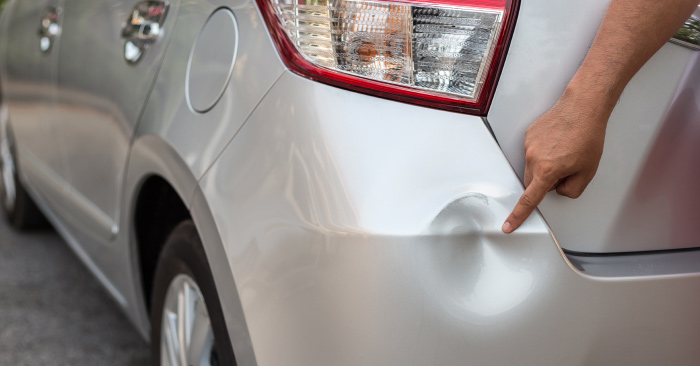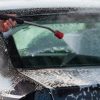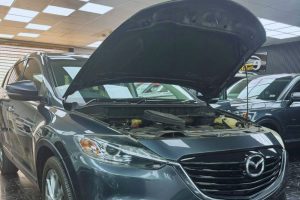The dent sitting on your car body could be a result of any incident in the surroundings, of which you might or might not be aware of. It would be best if you always took care to avoid car dents. But despite the amount of care and concern that is put into while driving or parking our cars, accidents happen. There are huge chances that we receive a screechy/valleyed/pointy welcome from a new dent sitting on the car body.
The marks could be a result of a cart or a shopping trolley, a kid getting his football’s aim wrong or someone opening their car door a little too harsh in a compact parking space. The good news here is that not all the dent types are the same, and the damage is correctable. All you need is a professional’s help to get the dent, crease or ding’s effect on your car paint and metalwork fixed.
Common Car Dent Types
You might need to sort to repainting or even panel replacement to fix the huge, more profound and extensive dents on your car. It is important that you understand the cause of the dent to figure out the appropriate remedy.
While some car dent types might cause a scar on the exterior, the other type might imprint a wrong mark, beyond what’s visible to the naked eye. The tricky dents are the ones which will dupe you with the face of a superficial scar when instead it runs a long way into the damage on the original car finish.
The Common Types of Dents Are as Follows:
Dings
These are minor dents on the surface caused by a rock or another exterior force/object hitting the surface but having lower indentation (equal to or less than half-inch in diameter).
Sharp Dents
Sharp dents are the trickiest of all dent types. These are usually the result of any small metal object slamming fast across your car’s exterior surface. The small metal object will leave a sharp mark on the surface, but the damage might be more significant below the panels.
The larger panels having sharp dents in between them have their original metal direction corrupted. These sharp dents are more challenging to repair depending on the damage done on the original metalwork of the car’s body.
Round Dents
Round dents are another common category of car dents with its significant appearance. These are round-shaped hollow dents that leave a sunken and shallow mark on the surface. Sometime funnel-shaped, these might be resulting from a swift hit from a ball coming with kids playing near your car parked spot, hailstones or other round objects.
Paintless dent removal forms a fresh approach in rectifying the dent’s damage. Depending on the extent of damage to the metalwork and paint of the car’s exterior, the professionals can take proper care of the sharp car dent repair with the use of specialised tools and techniques.
Creased Dents
Remember the irritating screeching noise coming when an object gets dragged on another sharp surface. The creased dents are a result of somewhat similar instances. Usually found on the side panels, these are caused when an object initially causes a massive impact on the metal surface and is then dragged along the panel.
It takes adept skills to be able to distinguish a crease from a round or sharp dent. A well-trained professional will be able to detect creases around the dent, caused by objects like a bicycle handle, trailers, tree branches, or door handles.
Numerous creases might damage the metal surface of your car’s exterior. Creased dents not only damage the metalwork but affect the original paint finish as well. The subsequent damage repair demand would not suffice with a paintless car dent removal technique and will instead call for the use of specialised tools and a professional approach.
Difference Between Car Dings and Dents?
Contrary to the common belief of all dents being the same, they differ based on what caused the indentation and the extent of the damage caused.
The difference between a car ding and a car dent has got to do with the extent and size of the damage. The one where the diameter of the indentation on the car’s body is not more than half an inch is the car ding, and the type with extensive damage is the car dent. Car dings are mostly a result of a trolley’s scratch, rocks hitting the car body or careless door hits.
Irrespective of the reason following your car dents, it needs to get repaired. The car dent repair varies based on the cause of damage and its scale. While some dents tend to scratch and affect the original metal and paintwork, there are a few other types that are mere compressions on the metal body and can be fixed easily with a quick paintless car dent repair service. The other huge damage dent-kind need specialised tools and professional techniques for its complete repair.
What Kind of Dents Can Be Repaired?
Whether it is a simple car ding or a more extensive round dent, sharp dent or a creased one, all kinds of dents can be repaired depending on the extent of the damage done on the metal work of the car’s exterior.
Car dings have no effect on the paintwork or metal finish and are mostly about the superficial damage (less than half an inch in size). Neither the metal nor paint gets exposed to risk the appearance of crust followed by the ding’s scar. Paintless Dent Repairs form an excellent method to rectify the ding and repair the surface.
Are you searching for the best service providers to get your car’s dent removal done? If you’re a resident in the UAE and are looking for the best car service providers in the region, visit our website, to complete your quest and get all your car care queries answered. Carcility is your one-stop solution for all the car repair, service and maintenance needs. Book your service with Carcility and get instant transparent quotes. Select from the best service providers and avail the various service discount offers along with the benefit of live service tracking feature on your device from anywhere.
Download our car service app, now!







